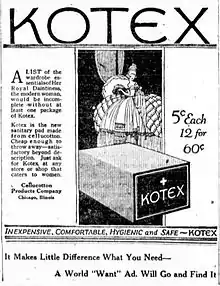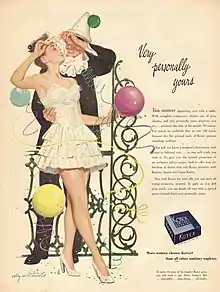Kotex
Kotex is an American brand of menstrual hygiene products, which includes the Kotex maxi, thin and ultra thin pads, the Security tampons, and the Lightdays pantiliners. Most recently, the company has added U by Kotex to its line of menstrual hygiene products.[1] Kotex is owned and managed by Kimberly-Clark, a consumer products corporation active in more than 80 countries.
 A Kotex "Deo" pad | |
| Product type | Menstrual hygiene products |
|---|---|
| Owner | Kimberly-Clark |
| Country | United States |
| Introduced | 1920 |
| Website | Kotex corporate website |


History
The modern, commercial, disposable pads seem to have started in the late nineteenth century with the Hartmann company in Germany, and Johnson & Johnson in the United States.[2] In the UK, the Birmingham firm of Southall Brothers & Barclay was advertising "sanitary towels" in The Family Doctor and Home Medical Adviser in the early 1890s.[3]
In the United States, Kotex was launched in 1920 by Kimberly-Clark to make use of leftover cellucotton (wood pulp fiber) from World War One bandages.[4][5] An employee noted that the pads had a "cotton-like texture" which was abbreviated to "cot-tex" and then made the product name with alternate spelling.[6]
Kotex became well known in the 1920s after Kimberly-Clark placed advertisements in the women's magazines Good Housekeeping and Ladies' Home Journal.[7] Although some readers were offended by the ads, the products' success led to more advertisements. Kimberly-Clark also promoted Kotex in Good Housekeeping by using intimate advice columnist Mary Pauline Callender.[8]
Originally sold in a hospital blue box at 12 for 60 cents, Victorian sexual prudishness caused slow acceptance until Montgomery Ward began advertising them in its 1926 catalog, reaching $11 million sales in 1927 in 57 countries.[9] It became one of the first self-service items in American retailing history after it was strategically placed on countertops with a special payment box so that the woman didn't have to ask a clerk for it and touch hands. Tampax appeared in 1936. Belts were needed until the 1970 introduction of Stayfree by Personal Products Co. and New Freedom Pads by Kimberly-Clark.
New Freedom is a former brand in the Kotex family. New Freedom was one of the first beltless pads manufactured in the early 1970s.
Product line
In August 2009 Kotex launched a premium sub-brand called Kotex Luxe in Singapore. It launched U by Kotex Tween, products aimed at girls aged 8–12 in the US in 2011.[10]
Recalls and defects
In September 2012 Kimberly-Clark issued a warning regarding a shipment of rejected Kotex tampons that had been stolen and sold to the public. The company said that the defective products posed only a minor health risk to consumers.[11]
In December 2018, Kimberly-Clark issued a recall of U by Kotex Sleek tampons due to findings that the product would sometimes break apart during removal, leaving behind fragments in the body that could require medical attention for removal.[12]
Notes
- Newman, Andrew Adam (16 March 2010). "Rebellion Against the Usually Evasive Menstrual Care Ad". The New York Times. p. B3. Retrieved 17 June 2015.
- "Pads [Directory]". Museum of Menstruation. Retrieved 17 June 2015.
- "Southall's towels". Museum of Menstruation & Women's Health. Retrieved 2020-09-02.
- www.mum.org
- www.mum.org
- Eschner, Kat (2017-08-11). "The Surprising Origins of Kotex Pads". Smithsonian Magazine. Retrieved 26 February 2020.
- Cross, Mary (2002). A Century of American Icons: 100 Products and Slogans from the 20th-Century Consumer Culture. Greenwood Press. pp. 86–87. ISBN 978-0313314810. Retrieved 4 September 2020.
- "Photo of Mary Pauline Callender". Museum of Menstruation. Retrieved 17 June 2015.
- http://www.straightdope.com/columns/read/2252/who-invented-tampons
- Newman, Andrew Adam (14 April 2011). "A Younger Group for Feminine Products". The New York Times. p. B3. Retrieved 17 June 2015.
- "Kimberly-Clark issues warning about stolen tampons". USA Today. Associated Press. 5 September 2012. Retrieved 17 June 2015.
- "Kimberly-Clark issues recall after reports of tampons causing users to seek medical attention". Fox 8 Cleveland. December 12, 2018. Retrieved December 12, 2018.
References
- Marchand, Roland (1985). Advertising the American Dream: Making Way for Modernity, 1920–1940. Berkeley, Cal.: University of California Press. pp. 20–23 et al. ISBN 9780520052536. OCLC 11574067.
Further reading
- Guadagnolo, D. (2020). "“The Miracle of You”: Women's Sex Education and the Marketing of Kotex." Modern American History
- "The Accidental History of Kleenex & Kotex". Alan's Mysterious World. September 30, 2009. Retrieved 17 June 2015.
- Mikkelson, Barbara (May 19, 2011). "Padded Account". Snopes.com. Retrieved 17 June 2015. On the origin of Kotex sanitary napkins. Cites:
- Gershman, Michael (1990). Getting It Right the Second Time: How American Ingenuity Transformed Forty-Nine Marketing Failures into Some of Our Most Successful Products. Reading, Mass.: Addison-Wesley. pp. 31–37. ISBN 9780201550825. OCLC 21407250.
External links
| Wikimedia Commons has media related to Kotex. |